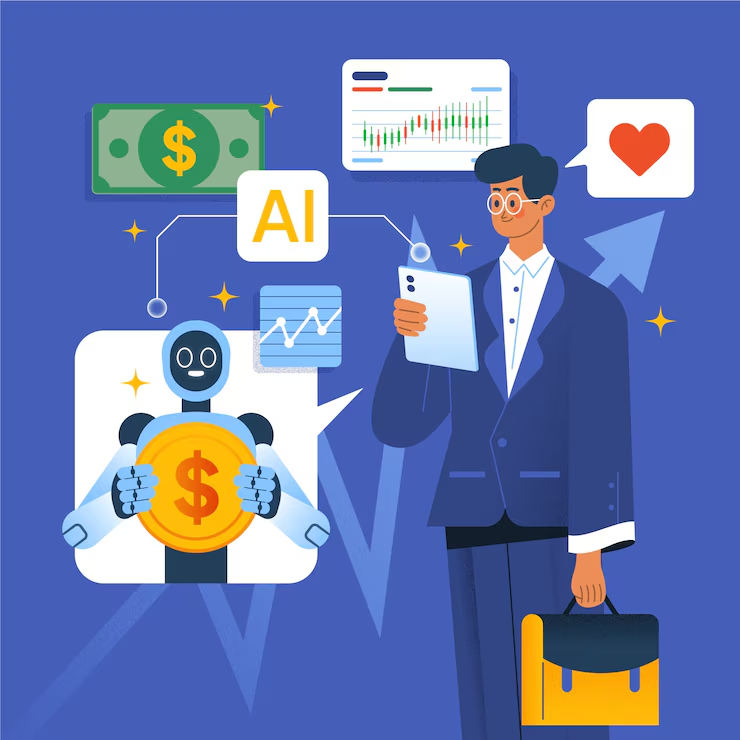Banking and finance have always been at the forefront of any technology breakthrough. Today, with society going digital first, AI in banking is changing how banks work: automating routine operations and giving customers highly individualised experiences. The banking sector indeed has moved toward the employment of AI as its intensifying competition and the ever-changing expectations of customers have ensured that banking will offer tremendous productivity improvement and restructured decision-making processes as well as a total remake of the banking experience.
Reinvented because of this transformation-evolving in such forms as robotic process automation, machine learning, and natural language processing via the world of artificial intelligence technologies. Bankers can now operate their banks at the lowest operational expenditure ever, be forehanded on consumer behaviours, and process large quantities of transactional information in real-time. By enhancement, the financial ecosystem has become smarter, faster, and safer. There are countless and highly relevant applications of AI, from simple chatbots using AI to answer questions to complex predictive analytics for enhanced risk management.
The global financial landscape is witnessing an unprecedented level of innovation as institutions invest extensively to incorporate AI into their structures. Beyond providing solutions to such long-standing challenges as fraud detection and regulatory compliance, AI has opened up completely new avenues in financial services. This article covers the major application areas of AI, how AI is transforming the financial sector, and how this could influence finance’s direction for the future.
AI for Banking
RPA and machine learning applications, and even natural language processing, fitted into the arsenal of an innovative bank for future applicants, have transformed the entire operation of banking and made it possible for every bank to assess enormous amounts of real-time data with an astonishing speed and accuracy and help in predicting customer behaviour with the least errors through their high responsiveness in assessing different factors concerning the risks. The areas where AI will considerably influence the future of banking are the following:
1. Better Experience for Customers
Customer service is undergoing tremendous changes because of the advancement of chatbots and virtual assistants propelled by AI. For example, an AI assistant at Bank of America named Erica promptly gets back with replies to consumer inquiries. AI can also make individual recommendations, ensuring clients get specific financial advice through its examination of previous transactions and spending patterns.
2. Risk management and fraud detection
The financial sector is now very sensitive to fraudulent behaviour. Artificial intelligence systems look into patterns of transactions in search of any abnormalities and report potential fraud on the spot. For instance, AI lowers JPMorgan Chase’s chance of fraud occurrences significantly as millions of transactions occur each day under the system.
3. Automation of processes
RPA has already been employed in automating repetitive processes that involve document processing, account verification, and loan approval. This quickens the delivery of services while minimizing operational costs as well as errors.
4. Analytics for Forecasting
AI’s capability to analyze past data will help banks anticipate consumer and market trends. As a result, organizations can now make data-based decisions, from determining creditworthiness to identifying potential areas of investment.
The Impact of AI on Banking Operations
AI is streamlining back-office functions in addition to making front-office functions better. Banks can gain more productivity and improve their activities by using AI. The way of banking processes is changing in the following areas:
- Credit scoring and loan approvals: AI-based models, looking at non-traditional data points such as social media activities and digital footprints, determine creditworthiness much more accurately.
- Artificial intelligence: It simplifies compliance processes by making it easy for regulatory reporting and monitoring to be done.
- Cyber security: Advanced AI system protects sensitive financial data and recognizes and blocks potential threats.
Challenges in Implementing AI in Banking
AI has a bright side, but its introduction into banking is not without difficulties.
- Data Privacy Issues: Banks must ensure that the data of their clients dwells within the architecture of confidentiality and is handled responsibly.
- High Implementation Costs. Developing and setting up an AI system is relatively high.
- Skill Gaps: The need for skilled professionals who can design as well as manage AI systems is growing.
Artificial Intelligence Prospect in Banking
The use of AI in banking is expected to be highly accelerated. According to Juniper Research, the banking sector will spend about $84.99 billion on generative AI by 2030, at a compound annual growth rate of 55.55%.
These major trends are impacting the future.
- Hyper-personalization: The AI will present experiences tailored strongly to the wishes of every individual customer.
- Blockchain Integration: AI and blockchain will make banking transactions safer and more transparent.
- Open banking ecosystems: The AI will help integrate the banks and external service providers seamlessly.
The Ways Financial Software Development Companies Engage with AI Development
For banks to use AI, they must get a financial software development company. These companies offer customized development of banking software development services meant for certain requirements. Based on such knowledge, the banks will use AI to:
- Design AI client engagement systems.
- Reliable fraud detection mechanisms are put in place.
- Streamline operating procedures.
For example, banks can accelerate digital transformation by leveraging AI and finance software development solutions provided by Hidden Brains, a top supplier.
Impact in the Real World: AI in Banking by the Numbers
The following data indicates how AI impacts banking:
- An estimated 35 billion has been invested into AI by financial services sector stakeholders in 2023, in which banking investments have been dominated by an approximate 21 billion.
- By 2030, the banking industry is expected to spend a whopping $84.99 billion on generative AI, with a compound annual growth rate of 55.55%.
- The AI market in banking is projected to grow from a size of $11.62 billion in 2024 at a CAGR of 32.36% until 2031, attaining a valuation of $90.97 billion.
Conclusion
By enhancing client experience, improving processes, and addressing critical issues such as cybersecurity and fraud detection, AI in banking is altogether transforming the financial sector. With the assistance of AI, banks can focus on innovation and strategic growth by automating simple jobs and delivering bespoke financial products. As artificial intelligence develops further, its integration with blockchain and the Internet of Things is expected to transform banking and create a customer-centric, efficient, and safe industry.
Overcoming constraints such as data privacy, installation costs that tend to be very high, and lack of necessary skills can be achieved by adopting strong banking software development services and making strategic alliances with financial software development companies. Banks that adopt AI now put themselves in a leadership position and gear themselves for thriving in a financial environment that is not only competitive but is changing at lightning speed. This is the future way of building a more imaginative, diverse, and sustainable financial environment using AI in banking.

